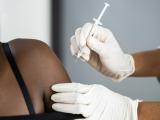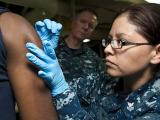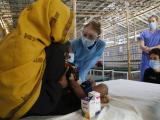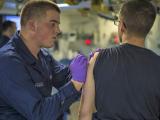Oct 23, 2008 (CIDRAP News) – The federal Advisory Committee on Immunization Practices (ACIP) has opened the door to voluntary anthrax vaccination for first responders, revising an 8-year-old recommendation against that step.
The committee, meeting yesterday, said the risk of anthrax exposure for emergency responders is low but "may not be zero," and therefore first-responder agencies may want to offer the vaccine on a voluntary basis, according to information supplied by the Centers for Disease Control and Prevention (CDC) today.
The CDC routinely adopts the ACIP's recommendations.
Anthrax vaccination—which currently involves six doses over 18 months, followed by annual boosters—is required for US military personnel serving in the Middle East and other high-risk areas. Nearly 2 million service members have been vaccinated under the program, according to ACIP reports.
However, a number of military members have complained of negative side effects from the shot, and a lawsuit by several of them interrupted mandatory vaccinations for about 2 years starting in October 2004. Another lawsuit against the program is still in the courts.
Allowing the option
The new recommendation adopted by the ACIP does not actively encourage anthrax shots for first responders. It states:
"Emergency and other responders, including police departments, fire departments, hazardous material units, government responders, the National Guard and others, are not recommended for routine pre-event anthrax vaccination. However, the committee recognized that while the risk of exposure for first responders to anthrax is low it may not be zero. Therefore, first responder units may choose to offer their workers pre-event vaccination on a voluntary basis. The vaccination program should be carried out under the direction of a comprehensive occupational health and safety program."
In 2000 the ACIP recommended against "pre-event" anthrax shots for first responders, and that stance was reaffirmed when the committee revisited the issue after the anthrax attacks of late 2001, according to an online summary of the June 2008 ACIP meeting. The reasons for reconsidering that recommendation included a growing supply of the vaccine and new data suggesting a change in the vaccine's safety profile, plus interest from some first-responder groups, according to comments made at that meeting.
Interest from emergency responders
A change in the recommendation for first responders was proposed at the June meeting by an ACIP subcommittee called the Anthrax Vaccine Workgroup. The panel's work was described by Jennifer G. Wright, DVM, MPH.
"Post-event vaccination in combination with antibiotics is an effective intervention following exposure to B[acillus] anthracis spores, but the workgroup felt that pre-event vaccination could offer additional protection beyond that afforded by antibiotics and post[exposure] vaccination by providing early priming of the immune system," the meeting summary states. "Some respondent organizations have stated that their members would be more willing to respond to a bioterrorism event if they were vaccinated prior to the occurrence of the event."
Dr. Richard Besser, director of the CDC's Coordinating Office for Terrorism Preparedness and Emergency Response, commented at the June meeting that a number of emergency response agencies had indicated interest in preemptive anthrax immunization for their workers, but the existing negative recommendation was seen as an impediment.
Also at that meeting, the CDC's Nancy Messonier said that the workgroup's intent in proposing a change was "to open the door, knowing that the vaccine is commercially available and that first responder groups are at liberty to call the manufacture to obtain the vaccine themselves," the meeting summary states.
The FDA-licensed vaccine, called anthrax vaccine adsorbed (AVA) (Biothrax), is made by Emergent BioSolutions Inc. Current annual production capacity is 8 million to 9 million doses, up from about 2 million in 2002, the June meeting report says. A new manufacturing facility that is being tested will eventually boost production to as many as 30 million to 35 million doses, it says.
"The workgroup felt that at the current time, vaccine supply was sufficient to support vaccination for a large group of individuals," the report states. It says the nation may have as many as 3 million first responders, depending on how the term is defined.
The work group concluded that the risk of anthrax exposure for first responders through a bioterrorism event is "undefinable," the summary states. However, the group concluded that the available data suggest that the vaccine is safe and effective.
Fewer adverse events
Through June 2008, 4,705 reports of adverse events associated with anthrax vaccination of military personnel were filed with the government's Vaccine Adverse Event Reporting System, the report says. That represents a rate of 61.1 reports per 100,000 doses, as compared with 117 reports per 100,000 doses of smallpox vaccine. About 10% of the reports described "serious" adverse events.
The report also said that in February the ACIP looked at data showing a decrease in local adverse events when the vaccine was given intramuscularly rather than by the standard subcutaneous route. That was an apparent reference to interim findings in a CDC study, which were reported in the Oct 1 Journal of the American Medical Association (JAMA; see link to news story below).
The JAMA report said people who were vaccinated intramuscularly had fewer injection-site reactions after four doses than those who received subcutaneous shots. It also said those who received three intramuscular shots in the first 6 months had about the same immune response as those who received the standard four subcutaneous shots, suggesting that dose reduction may be possible.
Discussion at the June ACIP meeting pointed out the challenges that would be posed by any effort to vaccinate large numbers of first responders, given the number and timing of doses involved. These include determining who would administer the vaccine, tracking recipients to keep them on schedule, providing liability coverage, monitoring adverse events, and caring for those who experience adverse events.
Postexposure protection
At yesterday's meeting, the CDC reported, the ACIP also made a recommendation on postexposure protection against anthrax: 60 days of antimicrobial treatment in combination with three doses of vaccine. Vaccine should be offered within 10 days of exposure.
"Anthrax vaccine is not licensed for children and has not been studied in children," the CDC update said. "However, postexposure anthrax vaccination in children potentially exposed to anthrax may be considered on an event-by-event basis in conjunction with 60 days of antibiotics."
The recommendation on postexposure prophylaxis includes pregnant women. "Pregnancy is neither a precaution nor a contraindication. Pregnant women should receive vaccine and antibiotics if they are exposed to inhalation anthrax," the CDC said.
See also:
Minutes of June 2008 ACIP meeting, including discussion of anthrax vaccine
http://www.cdc.gov/vaccines/recs/acip/downloads/min-archive/min-jun08.pdf
Oct 6 CIDRAP News story "Trial offers hope for shortening anthrax-shot series"
Oct 2 CIDRAP News story "To blunt anthrax attack, mail carriers to get antibiotics"


















